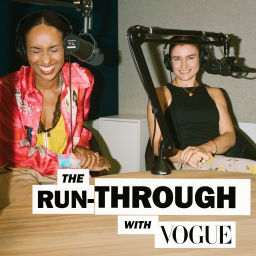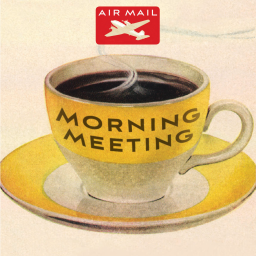
by The Business of Fashion
Welcome to The Debrief, a new weekly podcast from The Business of Fashion, where we go beyond the glossy veneer and unpack our most popular BoF Professional stories. Hosted by BoF correspondents Sheena Butler-Young and Brian Baskin, The Debrief will be your guide into the mega labels, indie upstarts and unforgettable personalities shaping the $2.5 trillion global fashion industry.<hr><p style='color:grey; font-size:0.75em;'> Hosted on Acast. See <a style='color:grey;' target='_blank' rel='noopener noreferrer' href='https://acast.com/privacy'>acast.com/privacy</a> for more information.</p>
Language
🇺🇲
Publishing Since
4/13/2022
Email Addresses
1 available
Phone Numbers
0 available

April 29, 2025
<p>Viral microtrends, the fleeting aesthetics popularised on platforms like TikTok, have defined recent fashion moments for young consumers. From the playful "Cottagecore" to the fleeting "Mob Wife", these trends have rapidly cycled through social media feeds and retail shelves. Post-pandemic experimentation drove this cycle, however, the once-accelerating churn of microtrends is beginning to slow, as Gen-Z shoppers seek authenticity, durability and individuality in their fashion choices. </p><br><p>On this episode of The Debrief, senior editorial associate Joan Kennedy joins senior correspondent Sheena Butler-Young to talk about what's behind the slowdown in microtrends and what this shift means for retailers and brands.</p><br><p><strong>Key Insights: </strong></p><p><br></p><ul><li>Microtrends gained momentum post-pandemic when young consumers had extra savings, more leisure time, and a desire to explore various identities through fashion. However, the novelty and playful experimentation eventually led to consumer fatigue. Kennedy explains, "Young shoppers are really looking to grasp onto something solid right now," noting an increased awareness that many trends felt "goofy" or even "fake." She adds, “people are talking more than ever about just this viral churn and how wasteful it is."</li></ul><p><br></p><ul><li>Young consumers increasingly align their fashion choices with specific cultural events, creating marketing opportunities for retailers. "This whole sense of 'what I am doing is how I'm dressing' has become very popular among young shoppers," Kennedy explains, highlighting opportunities around events like the Barbie movie and Beyoncé’s Cowboy Carter tour. </li></ul><p><br></p><ul><li>Retailers can better predict long-lasting trends by monitoring multi-season appeal and connections beyond social media. Kennedy cites Revolve's chief merchandising officer, Divya Mathur, who recommends looking for trends that "span multiple seasons" and have relevance across social media, runway, and pop culture. Kennedy advises retailers to "lean into more evergreen, identity-based marketing," and rethink "what virality looks like" as consumer engagement evolves. “With a lot of these trends, something goes viral and a brand gets a tonne of sales. But let's take a step back as that might shift and brands have to be ready for that.” </li></ul><p><br></p><p><strong>Additional Resources:</strong></p><ul><li><a href="https://www.businessoffashion.com/articles/marketing-pr/do-viral-microtrends-still-matter-for-fashion/" rel="noopener noreferrer" target="_blank"><strong>The Decline and Fall of the Viral Microtrend | BoF</strong></a><strong> </strong></li><li><a href="https://www.businessoffashion.com/articles/marketing-pr/the-life-cycle-of-a-viral-fashion-trend/" rel="noopener noreferrer" target="_blank"><strong>The Life Cycle of a Viral Fashion Trend | BoF</strong></a></li><li><a href="https://www.businessoffashion.com/articles/technology/how-the-internet-disrupted-fashions-trend-cycle/" rel="noopener noreferrer" target="_blank"><strong>How the Internet Disrupted Fashion’s Trend Cycle | BoF</strong></a><strong> </strong></li><li><a href="https://www.businessoffashion.com/articles/marketing-pr/how-to-keep-up-with-tiktoks-lightning-fast-trend-cycle/" rel="noopener noreferrer" target="_blank"><strong>How to Keep Up With TikTok’s Lightning-Fast Trend Cycle | BoF</strong></a><strong> </strong></li></ul><p><br></p><hr><p style='color:grey; font-size:0.75em;'> Hosted on Acast. See <a style='color:grey;' target='_blank' rel='noopener noreferrer' href='https://acast.com/privacy'>acast.com/privacy</a> for more information.</p>

April 22, 2025
<p>From the legendary Hermès Birkin to recent sensations like Alaïa’s Teckel, luxury handbags have long held a distinctive power within the fashion world. Blending brand heritage, practicality, and emotional resonance, handbags often become a signature item for brands to capture consumer attention and drive commercial success. But the ongoing challenge for luxury brands is maintaining innovation, managing consumer desire, and navigating a landscape rife with copycats and shifting trends.</p><br><p>On this episode of The Debrief, senior correspondent Sheena Butler-Young speaks with luxury correspondent Simone Stern Carbone about the power of an iconic handbag and the delicate balance brands must achieve to keep them relevant.</p><br><p><strong>Key Insights: </strong></p><p><br></p><ul><li>Bags often become the most recognisable symbols of luxury brands, significantly contributing to their financial performance. For instance, Alaïa’s Teckel bag – a playful, wiener dog-shaped design – helped offset the weaker performance of parent company Richemont’s other fashion labels. “That one bag was able to do so much, not just for the brand but for the larger company that the brand sits under,” says Stern Carbone. “That just says so much about the impact that a single wiener dog-shaped bag can potentially have.”</li></ul><p><br></p><ul><li>Handbags are particularly attractive as entry-level luxury items because they are recognisable status symbols. “Consumers might not recognise jeans from Bottega, but they will recognise whether a bag is Louis Vuitton,” explains Stern Carbone. “Bags are something that people will purchase time and time again; they will use them daily. And if done right, it really becomes the totemic product for a brand.”</li></ul><p><br></p><ul><li>Successful handbag designs can become immediate targets for imitation due to limited legal protections and the ease of replicating shapes and materials. “Once the bag gets copied, it's already over,” notes Stern Carbone, underscoring the need for continuous innovation or artificial scarcity, as mastered by Hermès with its Birkin and Kelly bags.</li></ul><p><br></p><ul><li>Brands must innovate thoughtfully, staying true to their heritage and core identity rather than pursuing novelty for novelty’s sake. “Empower your creative design teams and give new voices a chance,” advises Stern Carbone. “The beautiful thing is there's variety for everybody. Brands just need to authentically strike the cord with their loyal consumer base… and handbags are a way to do it.”</li></ul><p><br></p><br><p><strong>Additional Resources:</strong></p><ul><li><a href="https://www.businessoffashion.com/articles/luxury/in-a-market-of-copycats-handbag-innovators-stand-out/" rel="noopener noreferrer" target="_blank"><strong>In a Market of Copycats, Handbag Innovators Stand Out | BoF</strong></a><strong> </strong></li><li><a href="https://www.businessoffashion.com/articles/luxury/can-slouchy-work-bags-and-a-selfie-mirror-grow-delvaux/" rel="noopener noreferrer" target="_blank"><strong>Can Slouchy Work Bags and a Selfie Mirror Grow Delvaux? | BoF</strong></a><strong> </strong></li><li><a href="https://www.businessoffashion.com/articles/luxury/how-polene-is-growing-french-dtc-handbags-into-an-international-success/" rel="noopener noreferrer" target="_blank"><strong>How Polène Is Growing French DTC Handbags Into an International Success | BoF</strong></a><strong> </strong></li><li><a href="https://www.businessoffashion.com/articles/news-analysis/on-the-wings-of-celine/" rel="noopener noreferrer" target="_blank"><strong>On the Wings of Céline | BoF</strong></a><strong> </strong></li></ul><p><br></p><hr><p style='color:grey; font-size:0.75em;'> Hosted on Acast. See <a style='color:grey;' target='_blank' rel='noopener noreferrer' href='https://acast.com/privacy'>acast.com/privacy</a> for more information.</p>

April 15, 2025
<p>In early April, President Donald Trump announced an unprecedented wave of tariffs, imposing duties as high as 145 percent on imports from China. Among the rationales offered were the prospect of a US manufacturing renaissance.</p><br><p>The American fashion sector – heavily reliant on overseas production, particularly in China – now faces significant disruption. Some brands are adapting quickly, leveraging their domestic operations and leaning into a ‘Made in USA’ identity. Others are reevaluating their reliance on China as their primary sourcing destination. But the prospect of a mass return of garment manufacturing jobs remains a remote possibility, most economists and fashion industry experts say. </p><br><p>In this episode of The Debrief, BoF correspondents Malique Morris and Marc Bain join executive editor Brian Baskin and senior correspondent Sheena Butler-Young to assess whether the dream of American-made fashion is any closer to reality.</p><br><p><strong>Key Insights: </strong></p><p><br></p><ul><li>The ‘Made in USA’ dream remains out of reach due to the lack of US manufacturing infrastructure. "The infrastructure just literally isn't here," says Bain. "Even if you use US grown cotton, most of the time that cotton is shipped out of the US to be spun into yarn and woven into fabric somewhere else. These are all sorts of things that we just don't have here. It's been lost over decades and it would take decades to get it back.”</li></ul><p><br></p><ul><li>Brands that already manufacture domestically are seeing success from marketing craftsmanship, experience and emotional value. The outdoor clothing company Filson, for example, offers walking tours around their manufacturing facility that shares a space with their Seattle headquarters. “Fashion is already an emotional purchase, and consumers do care about the story behind a brand. That's why brand marketing is so important for building the label,” says Morris. “This is another way to tap into that. It's storytelling, not nationalism.” </li></ul><p><br></p><ul><li>Whereas the US has a lack of infrastructure for manufacturing, China is in the exact opposite position. Small brands might have their supply chain concentrated in one geographical area and are especially vulnerable to tariff changes. “If that area happens to be China and suddenly there's this giant more than doubling of tariffs, you are in serious trouble,” says Bain. </li></ul><p><br></p><ul><li>Although cheap overseas clothing companies like Shein and Quince will now be subject to increased duties, consumers won’t abandon cheap fashion overnight. “Even if [middle-class shoppers] are not going to buy American-made brands that are significantly more expensive, maybe they'll go second-hand, maybe they'll vintage,” says Morris. “I think the hope here is that people will just get conditioned out of the idea that they can get $2 jeans and a $10 dress.”</li></ul><p><br></p><p><strong>Additional Resources:</strong></p><ul><li><a href="https://www.businessoffashion.com/articles/retail/how-made-in-usa-brands-benefit-from-tariffs/" rel="noopener noreferrer" target="_blank"><strong>How Made-in-America Brands Turn Tariff Turmoil Into Opportunity | BoF</strong></a></li><li><a href="https://www.businessoffashion.com/articles/retail/why-made-in-america-fashion-fantasy-manufacturing/" rel="noopener noreferrer" target="_blank"><strong>Why ‘Made in America’ Is Still a Fashion Fantasy | BoF</strong></a></li><li><a href="https://www.businessoffashion.com/articles/news-analysis/the-myth-of-made-in-america-ttp-agreement/" rel="noopener noreferrer" target="_blank"><strong>Unravelling the Myth of ‘Made in America’ | BoF</strong></a></li></ul><p><br></p><hr><p style='color:grey; font-size:0.75em;'> Hosted on Acast. See <a style='color:grey;' target='_blank' rel='noopener noreferrer' href='https://acast.com/privacy'>acast.com/privacy</a> for more information.</p>

The Business of Fashion

Glossy

Audacy | Puck

Vogue

Who What Wear

Liv Perez

Chris Black & Jason Stewart / Talkhouse

Nymphet Alumni

Goop, Inc. and Audacy

Eyewitness Beauty

Dressed Media

Clare Press

Second Life

Air Mail

Throwing Fits
Pod Engine is not affiliated with, endorsed by, or officially connected with any of the podcasts displayed on this platform. We operate independently as a podcast discovery and analytics service.
All podcast artwork, thumbnails, and content displayed on this page are the property of their respective owners and are protected by applicable copyright laws. This includes, but is not limited to, podcast cover art, episode artwork, show descriptions, episode titles, transcripts, audio snippets, and any other content originating from the podcast creators or their licensors.
We display this content under fair use principles and/or implied license for the purpose of podcast discovery, information, and commentary. We make no claim of ownership over any podcast content, artwork, or related materials shown on this platform. All trademarks, service marks, and trade names are the property of their respective owners.
While we strive to ensure all content usage is properly authorized, if you are a rights holder and believe your content is being used inappropriately or without proper authorization, please contact us immediately at [email protected] for prompt review and appropriate action, which may include content removal or proper attribution.
By accessing and using this platform, you acknowledge and agree to respect all applicable copyright laws and intellectual property rights of content owners. Any unauthorized reproduction, distribution, or commercial use of the content displayed on this platform is strictly prohibited.
